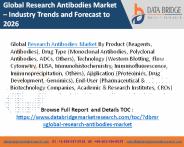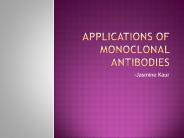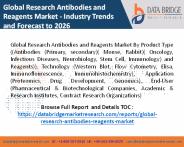Antibodies PowerPoint PPT Presentations
All Time
Recommended
elisa-based peptide assay for simultaneous measurement of antibodies against b. sensu stricto, b. garinii, b. afzelii, and detection of cross-reactive antibodies with
| PowerPoint PPT presentation | free to download
Antibodies The antibody and antigen shape match Antibodies recognize foreign proteins Special White Blood Cells make antibodies Antibodies can be made to ...
| PowerPoint PPT presentation | free to view
Bispecific Antibodies Market
| PowerPoint PPT presentation | free to download
Obstacles to Antibody Sequencing. Immunoglobulin fine structure ... A type of passive immunotherapy which employs intravenously injecting into ...
| PowerPoint PPT presentation | free to view
Production of long-lasting monoclonal antibodies is a recent invention and it is used in both medicine and research. Monoclonal Antibody: ...
| PowerPoint PPT presentation | free to download
Antibody, also called as immunoglobulin, is a protein produced by plasma cells in response to specific antigens. These antibodies can be used as therapeutic as well as diagnostic purposes for several indications, including cancers, autoimmune disorders, inflammatory & infectious diseases and others. The global antibodies market is estimated to account for US$ 147,385.1 Mn in terms of value and is expected to reach US$ 384,011.6 Mn by the end of 2027.
| PowerPoint PPT presentation | free to download
Treatment of Cancer Cancer cells carry specific ... Monoclonal anti-TAA antibodies have been produced. Drugs which kill tumour cells or inhibit key proteins in tumour ...
| PowerPoint PPT presentation | free to view
A broad spectrum of antibodies utilized in scientific research for applications including immunology, cancer, neurology, and cell biology are included in the research antibodies market. These antibodies are essential instruments for identifying, measuring, and isolating particular target proteins from biological materials. The market for research antibodies has grown significantly due to the quick development of biotechnology and the rising need for personalized treatment.
| PowerPoint PPT presentation | free to download
The global research antibodies market is estimated to garner a significant revenue by the end of 2033 by growing at a CAGR of ~X% over the forecast period, i.e., 2023 – 2033.
| PowerPoint PPT presentation | free to download
Monoclonal antibodies Anticancer therapy * * * * * * * * * Lymphocytes Produce antibodies B-cells mature in bone marrow then concentrate in lymph nodes and spleen T ...
| PowerPoint PPT presentation | free to view
Monoclonal Antibodies (mAbs) Antibodies (Abs). Also known as immunoglobulins (Ig). Comprised of 2 heavy chains and 2 light chains Monoclonal Abs bind specifically to ...
| PowerPoint PPT presentation | free to download
Immunohistochemistry (IHC) has become an indispensable tool in modern pathology, allowing for the visualization and characterization of specific proteins within tissue samples. At the heart of IHC are the antibodies, which bind to target antigens and facilitate their detection on pathology s. In this blog post, we delve into the significance of immunohistochemistry antibodies and their crucial role in unraveling the mysteries of disease pathology.
| PowerPoint PPT presentation | free to download
The arthritis monoclonal antibodies market size is expected to see strongly grown in the next few years. It will grow to $83.76 billion in 2028 at a compound annual growth rate (CAGR) of 7.7%.
| PowerPoint PPT presentation | free to download
Research antibodies are proteins utilized in the various areas of research, diagnostic studies and even therapeutics development. These proteins are utilized in cell research and development due to their ability for binding to specific molecule variants, which help in effective isolation and identification of cells.
| PowerPoint PPT presentation | free to download
The monoclonal antibodies market is projected to reach US$ 243.05 billion by 2028 from US$ 111.01 billion in 2021; it is expected to grow at a CAGR of 11.8% from 2021 to 2028.
| PowerPoint PPT presentation | free to download
Embark on a transformative journey with Assay Biotechnology, where innovation converges with excellence in the realms of antibodies, ELISA kits, and life science products. Our commitment to pioneering advancements in immunological research is reflected in the precision of our antibodies, the sophistication of our ELISA kits, and the comprehensive range of life science products we offer. Join us at the forefront of discovery as we redefine the boundaries of scientific exploration, empowering researchers worldwide with cutting-edge tools that shape the future of healthcare and biotechnology.
| PowerPoint PPT presentation | free to download
Immunohistochemistry Pathology Reporting System (IHC-PRS) stands at the forefront of modern pathology, offering a window into the intricate world of cellular biology. Central to this innovative approach are immunohistochemistry (IHC) antibodies, essential tools that unlock the potential of IHC-PRS in deciphering cellular structures and biomarker expression patterns.
| PowerPoint PPT presentation | free to download
Global monoclonal antibodies (mas) market size is expected to reach $424.24 Bn by 2028 at a rate of 12.8%, segmented as by source, murine, chimeric, humanized, human
| PowerPoint PPT presentation | free to download
In the intricate world of pathology, Immunohistochemical staining (IHC) emerges as a vital technique, casting a spotlight on cellular and molecular details that traditional methods might overlook. This blog post delves into the significance of Immunohistochemical staining and the pivotal role played by antibodies in unraveling the mysteries within tissues.
| PowerPoint PPT presentation | free to download
Global cancer monoclonal antibodies market size is expected to reach $95.99 Bn by 2028 at a rate of 9.8%, segmented as by monoclonal antibody therapies, avastin, herceptin, keytruda, opdivo, darzalex, perjeta, others
| PowerPoint PPT presentation | free to download
Monoclonal antibodies Anticancer therapy * * * * * * * * * * * * * * Cell culture Enzymatic Feedstock Bioprocessing Product GAS LIQUID SOLID PRODUCT LINES ...
| PowerPoint PPT presentation | free to view
Global diagnostic specialty antibodies market size is expected at $35.26 Bn by 2027 at a growth rate of 5.6% and analysis by The Business Research Company.
| PowerPoint PPT presentation | free to download
Antibodies or Immunoglobulins * Definition: Glycoprotein in serum and tissue fluid * Produced by: B-lymphocytes in response to exposure to antigen
| PowerPoint PPT presentation | free to view
MD.(2000).Monoclonal antibody. New England Journal Med. 405:362-365. * Title: CHRONIC MYELOGENOUS LEUKAEMIA Author: paschalis kourelias Last modified by: GolfTango
| PowerPoint PPT presentation | free to view
The global polyclonal antibodies market size is expected to grow from $1.27 billion in 2022 to $1.35 billion in 2023 at a compound annual growth rate (CAGR) of 6.3%.
| PowerPoint PPT presentation | free to download
The global arthritis monoclonal antibodies market grew from $49.44 billion in 2022 to $53.81 billion in 2023 at a compound annual growth rate (CAGR) of 8.8%.
| PowerPoint PPT presentation | free to download
The global arthritis monoclonal antibodies market grew from $49.44 billion in 2022 to $53.81 billion in 2023 at a compound annual growth rate (CAGR) of 8.8%.
| PowerPoint PPT presentation | free to download
The report Europe Antibodies Industry 2016 Market Research Report covers the whole industry outlook with value chain analysis, DRO's, production and sales volumes and figures.
| PowerPoint PPT presentation | free to download
... to the body, or to deal with altered host cells. ... From: http://www.antibodyresource.com/gallery.html. How Are Antibodies Produced. Inoculate animal ...
| PowerPoint PPT presentation | free to view
Chapter 4 Antigens and Antibodies Ab Ag Complementarity of interacting surfaces of Ab and Ag Oct 17, 19 & 24, 2006 Antigenic determinants on Igs 3 Antigenic ...
| PowerPoint PPT presentation | free to download
Read here the latest updates on the Antibodies market analysis published by the CMI team.
| PowerPoint PPT presentation | free to download
The Business Research Company offers neuroscience antibodies and assays market research report 2023 with industry size, share, segments and market growth
| PowerPoint PPT presentation | free to download
Embark on a journey through the fundamental aspects of Polyclonal Antibodies with a focus on their origin, intricate structure, and profound significance in life science research. This exploration encompasses the diversity of Polyclonal Antibodies, showcasing their versatility across fields and their pivotal role in cutting-edge research. Discover how these antibodies, including breakthroughs in Sandwich ELISA technology, contribute to the scientific landscape, with a special nod to the advancements from Assay Biotechnology.
| PowerPoint PPT presentation | free to download
mature B cell: ... Antibody-dependent cell-mediated cytotoxicity (ADCC) ... Established cell lines (hybridomas) that secrete any antibody that can be raised ...
| PowerPoint PPT presentation | free to view
Australia and New Zealand research antibodies market garnered a revenue of USD 101.4 million in the year 2019 globally and has been foreseen to yield USD 192.5 million by the year 2027 at a compound annual growth (CAGR) of 8.9% over the forecast period.
| PowerPoint PPT presentation | free to download
The global Research Antibodies Market size was USD 1.41 Billion in 2021 and is expected to register a revenue CAGR of 4.9% during the forecast period, according to latest analysis by Emergen Research. An increase in research and development (R&D) activities related to the fields of neurobiology, oncology and stem cell research, the increasing incidence of cancer and infectious diseases, and the growing demand from the biopharmaceutical industry for these antibiotics are the main drivers of the market. increase the revenue. Research antibodies are antibodies that can bind to specific molecules, which are used as basic detection tools needed in scientific research and are also important tools for studying protein function in cell.
| PowerPoint PPT presentation | free to download
1930s Heidelberger Quantitative precipitin reactions ... 2) precipitin reaction- which involves the binding of antibody molecules to ...
| PowerPoint PPT presentation | free to view
-Jasmine Kaur An antibody is a protein used by the immune system to identify and neutralize foreign objects like bacteria and viruses. Each antibody recognizes a ...
| PowerPoint PPT presentation | free to download
A rise in research activities in the neurobiology and stem cells’ field is one of the significant factors influencing the research antibodies market growth.
| PowerPoint PPT presentation | free to download
The actual portions or fragments of an antigen that react with receptors ... of an antibody as well as transplantation of a 17 amino acid alpha-helical DNA ...
| PowerPoint PPT presentation | free to view
According to the latest research report by IMARC Group, The global monoclonal antibodies market size reached US$ 207.4 Billion in 2022. Looking forward, IMARC Group expects the market to reach US$ 307.8 Billion by 2028, exhibiting a growth rate (CAGR) of 6.9% during 2023-2028. More Info:- https://www.imarcgroup.com/monoclonal-antibodies-market
| PowerPoint PPT presentation | free to download
The monoclonal antibodies market is projected to reach US$ 243.05 billion by 2028 from US$ 111.01 billion in 2021; it is expected to grow at a CAGR of 11.8% from 2021 to 2028.
| PowerPoint PPT presentation | free to download
Research antibodies and reagents are used to detect an unconjugated primary antibody that is used to target antigen. These help in are in detecting, measuring and purifying proteins or biomolecules in applications such as ELISA, flow cytometry, western blotting or immunohistochemistry.
| PowerPoint PPT presentation | free to download
Medical biology, microbiology, virology, immunology department ANTIBODIES. Cells cooperation in immune response. ANTIBODIES (IMMUNOGLOBUL1NS) are globulin proteins ...
| PowerPoint PPT presentation | free to view
The global breast cancer monoclonal antibodies market size is expected to grow from $15.37 billion in 2021 to $16.67 billion in 2022 at a compound annual growth rate (CAGR) of 8.5%.
| PowerPoint PPT presentation | free to download
The global monoclonal antibodies (mabs) market was valued at about $135.38 billion in 2018 and is expected to grow to $212.64 billion at a CAGR of 12.0% through 2022. Read more at http://bit.ly/2GvTbSs
| PowerPoint PPT presentation | free to download
Creative Biolabs has been dedicated to providing high-quality services in academic and life science worldwide. In the past decade, we have become a leader in discovering and manufacturing recombinant antibodies. https://www.antibody-creativebiolabs.com/
| PowerPoint PPT presentation | free to download
The research antibodies and reagents market consist of sales of research antibodies, reagents and related services by entities (organizations, sole traders and partnerships) that produce research antibodies and reagents to support a number of diverse research applications exploiting the ability of antibodies to specifically bind to molecules of interest. The revenue generated by the market includes the sales of research antibodies in the form of primary and secondary antibodies extracted from sources such as mouse, rabbit and others, and reagents like stains & dyes, media & serum, fixatives, buffers, probes, solvents, enzymes and others.
| PowerPoint PPT presentation | free to download
Clinical Uses for Monoclonal Antibodies. In vitro diagnostic agents. In vivo imaging agents ... Link a toxic drug, protein or radioisotope to an MAb with a ...
| PowerPoint PPT presentation | free to view
According to the latest research report by IMARC Group, The global monoclonal antibodies market size reached US$ 207.4 Billion in 2022. Looking forward, IMARC Group expects the market to reach US$ 307.8 Billion by 2028, exhibiting a growth rate (CAGR) of 6.9% during 2023-2028. More Info:- https://www.imarcgroup.com/monoclonal-antibodies-market
| PowerPoint PPT presentation | free to download
Clinical Uses for Monoclonal Antibodies. In vitro diagnostic agents. In vivo imaging agents ... First MAb on market was Orthoclone OKT3, a murine MAb ...
| PowerPoint PPT presentation | free to view
The global monoclonal antibodies (MABs) market is estimated to garner around USD 450 billion in revenue by 2031 by growing at a CAGR of nearly 14% over the forecast period, i.e., 2022 – 2031. The growth of the market can be attributed to increase in prevalence of cancer, rising demand for cost-efficient biosimilar monoclonal antibodies, and increase in R&D activities.
| PowerPoint PPT presentation | free to download
Latest research report “Monoclonal Antibodies (MAbS) Market” published by TBRC provides Market Analysis Forecast, Size, Trends, Key Players, Segments and Growth. Read Full Report: http://bit.ly/2ZqEI65 Request a Sample: http://bit.ly/30MTW1V
| PowerPoint PPT presentation | free to download
Global breast cancer monoclonal antibodies market size is expected to reach $27.8 Bn by 2028 at a rate of 8.3%, segmented as by product, naked mabs, conjugated mabs
| PowerPoint PPT presentation | free to download
Ordinary tumor therapeutic antibodies can only bind to a single antigen with a relatively low binding specificity is relatively low, which is prone to off-target effects. Bispecific antibodies (bsAbs) can recognize and bind two different antigens separately, so it can connect immune cells, viral molecules, etc. to tumor cells, thereby enhancing the killing effect on target cells, and it can also combine different antigens on the same tumor cell to enhance its binding specificity, thereby reducing side effects such as off-target toxicity.
| PowerPoint PPT presentation | free to download
Cancer Monoclonal Antibodies Pipeline Industry Analysis http://www.reportsnreports.com/reports/270800-global-cancer-monoclonal-antibodies-pipeline-analysis.html . In the past few years monoclonal antibodies have emerged as a therapeutic modality for cancer. These monoclonal antibodies are designed to selectively target cancer cells and extract various responses, thus indirectly protecting the non cancerous cells. This characteristic of monoclonal antibodies coupled with increasing potential of the oncology market has made many pharmaceutical giants to invest a significant portion of their R&D on cancer monoclonal antibodies.
| PowerPoint PPT presentation | free to download
























































